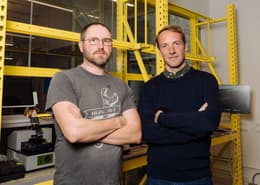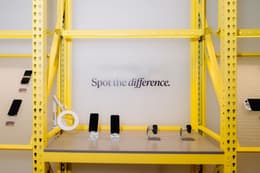
Crowds of activists, journalists, and business owners gathered at Back Market’s New York office to celebrate a new era of the Right to Repair movement.
A new era in Right to Repair
“The only difference between an Apple Genius and you is that Apple gave them permission to fix your phone,” Kyle Wiens, CEO of iFixit, told a crowd of journalists and activists gathered at the Back Market NYC office. Sound revolutionary? It is. Back Market has partnered with the e-commerce and how-to tech website to kick start a new era in the Right to Repair movement, forming a united front against manufacturers to open source repair, design easily repairable tech, and tackle e-waste.
iFixit and Back Market believe that every device should last at least 10 years. They’re starting with a commitment to extend average device longevity from 2 to 5 years, and expanding software longevity from 5 to 10 years.
Why? It’s pretty simple. If consumers hang on to their devices for just 3 more years, the device's carbon emissions are cut by 49 percent, preventing 15.6 million tons of CO2 emissions per year. Extend that to 10 years, and even including things like a screen and battery replacement, the device’s carbon emissions are cut by 68% compared to brand new. It’s only possible if manufacturers commit to repairable design and extending software compatibility for older models, and that’s what Back Market and iFixit aim to do.
A world where you don’t have to “upgrade” your phone every 2 years is closer than you think — and so do NY Senator Pat Fahy and former presidential candidate Andrew Yang, who were both in attendance.

A partnership that just makes sense
“The goal of our partnership,” said Back Market CEO Thibaud Hug de Larauze, "is to put ourselves in the shoes of the customer.” He also noted the strength of refurbishment — and doing more with what we already have — benefiting customers in the US regarding the fluctuating tariffs set by the current presidential administration. “We have 350 refurbishers working here in the US,” Hug de Larauze noted. “You can help the planet by being lazy,” joked Wiens, alluding to the hours many American customers spend in Verizon or AT&T stores slowly upgrading their phones. It’s an ethos that dovetails perfectly with Back Market’s mission to do more with what we already have.

L to R: Kyle Wiens and Thibaud Hug de Larauze
Putting repair in the hands of the people
Making repair accessible and easy for everyone can start long before anything goes wrong with your device. Ray Ho, VP of Product for Back Market, walked the audience through the new circularity focus of the Back Market app, spotlighting a new segment — dubbed “Care” — that helps connect users to the health of their device. Back Market’s new in-app diagnostics test everything from the microphone to screen sensitivity to the accelerometer, a key piece of tech that helps your phone track speed, direction — tracking the all-important step count. All things that you no longer have to go to an Apple Genius — or repair expert — to test.
But can the iFixit and Back Market partnership really help you physically repair your phone? As if on cue, Ho dropped his iPhone to the ground with a thud before tracking to the next slide that displayed, of all things, an iPhone with a cracked screen. Planned bit or dramatic coincidence? He’ll never tell — but it was a compelling way to showcase the new cleaning and repair kits iFixit developed for Back Market, available for purchase on the Back Market site, as well as being demoed after the panel by both Back Market and iFixit employees.
Building on the Right to Repair
Amongst the journalists and representatives from companies like Vestiare Collective and Refinery 29, New York State Senator Pay Fahy swirled through the crowd. Senator Fahy passed the first Right to Repair bill in the United States in 2022, after working on it during Covid. “When you saw the trauma we were facing then, especially with young people, repair is a way to boost the economy, help the environment, and support job creation,” she noted. Back Market’s American General Manager, Lauren Benton, shared that culturally, the idea of reusing is already here. “You live in someone else’s home, you drive someone else’s car, you rent a dress that’s already been worn by someone else — what’s different about our tech?” she said. The car analogy seemed prescient. After all, quipped Wiens, “would you ever throw away a car when it was time for an oil change?”
How Right to Repair helps the planet
Fast tech — the cycle of overproduction, overconsumption, and planned obsolescence — is the root cause of many issues tackled by the Right to Repair movement. When we repair and refurbish, we can avoid recycling. While perhaps unintuitive, “recycling is a last resort,” Back Market CMO Joy Howard explained. She debuted a short documentary, made by Back Market on a trip to Dandora Dump Site in Kenya, one of the largest e-waste recycling facilities in the world. The name, dump site, is telling. Sprawling dunes of e-waste are dug through by hand and salvaged for reusable parts and precious minerals. What’s reusable is shockingly small compared to the 250lbs of raw materials extracted from the earth needed to create a new phone. When we look to the future of the planet, it’s clear that refurbishment rather than recycling is the answer, and the easier we make repairs, the better off we will all be.

Back Market CMO, Joy Howard
What’s next
The future, noted Howard, is about “repair, care, and demanding change.” Back Market and iFixit’s partnership represents a sea change for consumers. If Big Tech manufacturers seriously commit, as the partnership aims to achieve, to longer-lasting devices, the drop in carbon footprint will just be the beginning. And they’re decidedly not alone. State Senator Fahy ended her panel by noting, “I’ve already been inspired to create two new bills.”











